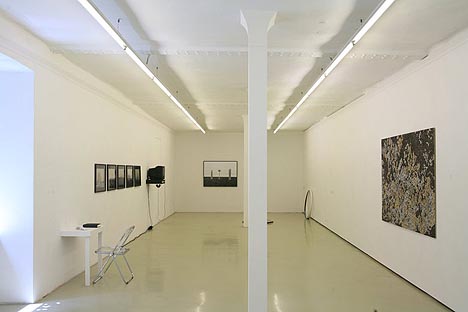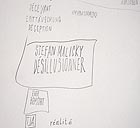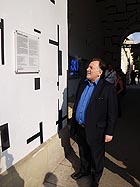
translated and summarized by: Liz Wollner-Grandville,
English summaries June 28 - July 10
Krinzinger Projekte
Artists in Residence Hungary 2010
01.07.11 – 10.09.11
Not nihilistic, extremely promising
Art is the deprivation of nothingness – something is being created that does not aim at anything specific except to represent a certain entity in contrast to not-wanting and not-meaning. Especially those who are just commencing their relationship with nothingness are exposed to losing themselves and failing. That is why one should at all times praise if one is offered the opportunity and the space to approach nothingness at eye level.
By founding the Residency in Petömhilálya (Hungary In 2010), Krinzinger Projects offered eight young artists this freedom, which – as this exhibition shows - bears beautiful fruits. Works by Eva Chytilek, Hajnalka Tarr and Rosmarie Lukasser are presented in the room on the left hand side. Among Tarr’s works are circular objects made of braille stampings placed on the floor. Both the nothingness and the something of the writing convey reflective glimmering aesthetics.
A large puzzle depicting Monet’s Olympia does not show the scandalous depiction of a cocotte with her hand between her thighs, but much more a camouflage pattern composition of different colour tones stapled in scales - thereby allowing the viewer to recover from the painting. Lukasser walked to Petömilhálfya in eight days and compiled a book about her tour with 120 images and a flip-book showing the images taken on her way back. The picturesque colourfulness of the five landscape photos taken with a pinhole camera is remarkable. Chytilek attracts attention with his huge black-and-white photograph showing three sculptures in an empty steppe landscape documenting defiance-against-nothingness. In the room on the right, one finds lovingly yet not painstakingly elaborated aquarelles by Klára Petra Szabó, in which young people dressed in lettered clothing escape complete anonymity on account of just this lettering. Zsolt Tibor shows five partly collaged drawings, interchanging between ironic amateurishness and meticulous aesthetics of construction – above one of his works hangs a mysterious antler form. Three uncut video works by Diána Keller play with the visual reversibility of time – while the watch moves anticlockwise, the flowers continue to decay. Henrik Martin presents two sculptures, a glowing Buddha made of stone and an “asteroid” covered by numerous snails as if fossilized. After pulling a curtain aside, visitors can enter Linus Reipler’s room-in-room. A narrow and low corridor leads to a larger space, which carries a touch of the creeps and offers beautiful music; after pulling two other curtain ropes you can admire a chrysalis formation.
The arrangement of the eight very different positions is noteworthy, and if you are afraid of nothingness, you cannot help but admire these young artists and wish them that they may continue to effectively thwart nothingness.
By Gesche Heumann
Krinzinger Projekte
1070 Vienna, Schottenfeldgasse 45
Tel: +43 1 512 81 42
Email: krinzingerprojekte@gmx.at
www.galerie-krinzinger.at/projekte
Galerie Martin Janda Raum aktueller Kunst
Jakob Kolding – The Uncertainty of Stability
24.06.11 – 30.07.11
Solace for enlightenment’s consolation
Prior to the era of enlightenment man was at the mercy of space and religion to find comfort for the imposition of space. Enlightenment allowed the gradual emergence of a position that made the desires for comfort and stability in day-to-day life more easily attainable. As measuring the world progressed, objects such as lightning rods, heating power stations, cars and many other things could be manufactured and utilized.
In his third solo exhibition at Martin Janda’s Gallery, the Danish artist Jakob Kolding demonstrates, with melancholic humour, that space, despite human interventions, is no less complex than it was. The two large works at the right of the entrance are predominantly in black – the colour of infinite space and deepest holes. In “The Night on its Back” (140x100 Lambda print, 2011) screen copies of a sitting headless man in a white shirt holding a cigarette in his left hand and wearing beautiful woollen socks together with a leopard, an eye surrounded by skin and an eyebrow, and 13 different sized white paper shavings are collaged in such a way that they resemble a pigeon seen from above. But naming this form “pigeon” is an insecure approach. What does someone who has the night on his back carry on his stomach? The day or the mattress on which he sleeps?
In another work, paper shavings fly out of opened hands – one of them depicting an illustration of mushrooms (Untitled, 140x100, Lambda print 2011). “City 2” (collage and illustration on paper, 66x102, 2011), presents a dancing dissipating male figure with a yellowish aerial view of a dock integrated in his face. All 21 works are collages – a formal method amalgamating various image spaces and thereby combining what should, according to logical measurement principles of the world, be kept apart. Some of the smaller works, presented as diptychs, play with the contrasts of black and white, show men in a formal formation, yet in rotor blade-like clips and contrasting corners, or hands attempting to balance skyscrapers or support unstable towers. In three instances one can find a portrait of the Argentinian surrealist Julio Cortázar in different contexts – the title of the exhibition was taken from that of a long short story by Corázar.
Prior to the era of enlightenment, mankind was mainly frightened by incommensurability. Today, in a time in which cucumbers are ploughed in masses to protect mankind from unidentified diseases, it’s relieving when immenseness comes together and does nothing but point to incommensurable spaces in which one may practice taking a walk.
By Charles Nebelthau
Galerie Martin Janda Raum aktueller Kunst
1010 Vienna, Eschenbachgasse 11
Tel: +43 1 585 73 71
Fax: +43 1 585 73 72
Email: galerie@martinjanda.at
www.martinjanda.at
Opening hours: Tue – Fri 11 a.m. – 6 p.m., Sat 11 a.m. – 3 p.m
Startgalerie im MUSA
Stefan Malicky – Désillusion
17.06.11 – 14.07.11
Avant-garde romanticism
Stefan Malicky’s restrained drawings strongly remind of 20th century classic avant-garde. Marcel Duchamp and André Breton come to one’s mind as well as Dadaism and Surrealism in general – mainly due to his use of literary quotes that are partly in French. It is exactly this era in which something Bohemian still existed (or at least how we envisage it) that this exhibition attempts to match.
Yet also other representatives of what we commonly summarize as “Modernism” emerge in Malicky’s drawings. One of his aquarelle illustrations reminds strongly of Piet Mondrian’s stringently constructed compositions dating back to the 1930s: rectangular colour patterns on a grid of black lines and bars against a white background. Fine pencil drawings remind of Cy Twombly or Robert Rauschenberg – in short, he seems to have processed half of last century’s art history; one cannot help to imagine the artist as an intellectual and his works as a form of theory.
A bookcase with an odd travel diary comprising computer printouts and handwritten notes - associating the artist with the old tradition of undertaking “study trips” - and a banana carton with a model of the gallery and the book “Illegitimate Art” by Luc Boltanski and Pierre Bourdieu, round out the image of an artist as a travelling thinker. To which extent this is considered a cliché or the consequent realisation of an ideal is up to the respective viewer.
That idealization and romanticism, including its intrinsically related irony, resonates in Malicky’s oeuvre - despite all sobriety – does no harm, on the contrary – one would wish for more.
By Wolfgang Pichler
Startgalerie im MUSA
1010 Vienna, Felderstrasse 6-8, next to the town hall
www.musa.at
Opening hours: Tue, Wed, Fri 11 a.m. – 6 p.m., Thu 11 a.m. – 8 p.m., Sat 11 a.m. – 4 p.m.
Tonspur Passage
Soundtrack 42: Peter Weibel – Life in the 20th century: 225 million murders
13.06.11 – 20.08.11
Centuries for the victims
“To relate about the infinity of death within the space of a few minutes by counting the number of dead is art’s ploy of depriving death of its totality” (Weibel)
For Peter Weibel, the well-known neo avant-gardist, silence and repression in art is a kind of defence mechanism. As a political artist, Peter Weibel lets his art, texts and lectures take a critical look at structures of state power, perceptions of democracy as well as mass media’s ambivalent role. He criticizes art’s complicity in the 20th century with its attempt to infinitely repeat exchanging representation and reality: art must stop serving as a vanishing point for transcendence and rituals.
Peter Weibel’s latest work on power and violence “Life in the 20th century: 225 million murders” (2011) is composed of a series of mixed media installations. In May, he presented an installation in Strasbourg (De la réalité virtuelle à la réalité augmentée, Apollonia), in which an iPhone - its screen content together with augmented reality - creates a connection between real and virtual space, providing the viewer with detailed information about political murders. The viewer has the option to target 10 freely flying virtual globes with mobile devices and access data on political murders, people killed in wars, genocides, etc. which all occurred between 1900 and 2000. Each of the 10 globes symbolizes one decade of the 20th century.
Weibel installed another variation of this series – an oratory with an infinite loop 8-tone sound installation – at Vienna's MuseumsQuartier for the 42. Tonspur-Passage (42. Soundtrack Passage). A female and a male voice read out the number of dead, where they were killed and the official name of the massacre. It would take several centuries to acknowledge each name of those murdered, therefore the 225 million dead are listed in a nameless statistic. The oratory was dedicated to the innocent victims as an “acoustic monument” (Weibel). Their lives are synonyms for death. A violent death, carried out for political reasons, is actually a double murder – something Peter Weibel defined as “real and symbolic”, because “politically murdered (…) die infinitely often.”
By Romana Schuler
Tonspur Passage
1070 Vienna, Museumsquarter/quartier 21
www.tonspur.at
Mehr Texte von translated and summarized by: Liz Wollner-Grandville


 Teilen
Teilen





